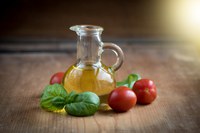Prairie Fare: Inspire Your Menus With Fresh Basil
(Click an image below to view a high-resolution image that can be downloaded)
By Julie Garden-Robinson, Food and Nutrition Specialist
NDSU Extension
When I want to relax a bit, I meander outside to tend my backyard plants, which include a variety of flowers, vegetables and herbs.
I don’t even mind weeding (too much) because my vegetable and herb gardens are in elevated 4-foot-wide by 8-foot-long garden boxes.
My garden beds are about 3 feet off the ground, so I don’t get dirty knees or a tired back when I am tending my plants.
My husband built the elevated gardens for me for Mother’s Day a couple of years ago. I admit the garden boxes were much better than the shirt I gave him that Father’s Day.
Thinking back, I gave him a fancy grill a few years ago, so I guess we are both happy with the long-term use of our gifts.
My herbs are doing especially well this year. I have basil, cilantro, parsley, chives and rosemary growing in part of a raised bed in a sunny spot.
Adding fresh herbs to your recipes is helpful beyond adding flavor. Basil has very small amounts of energy and nutrients, but it does provide a small amount of vitamin A. Basil flavors food without adding salt to recipes.
Recently, I was out of town a few days. When I checked my herbs after I returned, I noted my bushy basil plant was forming flowers. I removed the flowering heads, then I picked some basil. I wanted the plant’s energy to be used for making leaves, not flowers.
As I walked back to our house, I could smell the aroma of basil on my fingertips. It made me want to have a caprese salad or some fresh pesto.
A caprese salad with fresh basil is simple to make, especially when vine-ripened tomatoes are ready to pick. The caprese salad gets its name from the island of Capri, an island off Italy.
Besides ripe tomatoes, you need sliced fresh mozzarella cheese (available in many grocery stores), basil leaves and olive oil to make this famous salad. Layer the tomatoes and cheese with a basil leaf in between, then drizzle with olive oil and serve. Yes, it’s that simple.
Pesto, in case you never have made it, is prepared from fresh basil leaves, garlic, pine nuts, Parmesan cheese, olive oil, and salt and pepper processed in a food processor. You can mix pesto with rice, pasta or vegetables, or add some pesto to mayonnaise to add a little variety to a tuna salad sandwich. Numerous recipes to make pesto are available online.
Ancient Greeks called basil the “royal herb” because of its rich aroma, which adds flavor to a variety of dishes. Depending on the variety of the basil, some people detect notes of clove, citrus, cinnamon or licorice.
I could pick basil out of a crowd of flavors with my eyes closed, I think.
Basil can be grown indoors or outdoors. If you don’t have a garden spot outdoors, you just need some nutrient-rich soil and a container with good drainage to grow it like a house plant indoors. Be sure not to overwater basil.
To grow basil outdoors, be sure the soil has warmed sufficiently. Find a spot with plenty of sun, at least six hours a day, according to most horticulture experts.
Pick the leaves from basil plants regularly and they will flourish. However, don’t pick all the leaves or the plant may die. According to horticulture references, leave at least one-fourth of the leaves on the plant and remove the flower heads as soon as you see them.
Be sure to rinse fresh basil under running water, then pat it dry before using it. You can keep it a few days in your refrigerator, or you can freeze it.
To freeze basil, first remove the stems and blanch the leaves in boiling water for three seconds. Then dry the basil with a paper towel and separate leaves to put into a freezer-tight bag. Another way to freeze basil is to puree it and put it into an ice cube tray. Then cover the tray and freeze.
You also can dry fresh basil, but you will notice flavor changes as a result of drying. If you choose to dry basil, separate each leaf with the stems removed. If using a food dehydrator, follow the manufacturer's instructions.
Leaves are done when they are completely dry and crumbly. Once leaves are dry and cool, place them in an airtight container and store for up to one year.
As with any fresh herb, you will use two to three times the amount of fresh herb as you would the stronger-tasting dried herbs. In most recipes, add fresh herbs close to the end of cooking to preserve the herbs’ delicate flavor.
Be a little adventuresome with your indoor and outdoor plants. Add some basil to the mix.
Here’s a simple salad that adds color and flavor to a backyard grilling menu.
Fresh Tomato, Basil and Avocado Salad
1/4 c. extra virgin olive oil
2 Tbsp. balsamic vinegar
1 tsp. fresh minced garlic
1/4 tsp. salt
1/8 tsp. fresh cracked black pepper
2 ripe avocados, halved, seeded, peeled and diced
2 pints grape or cherry tomatoes, halved
1/3 c. loosely packed fresh basil ribbons (or chopped basil)
Whisk together the olive oil, balsamic vinegar, garlic, salt and pepper in a bowl and set aside.
In a separate bowl, mix tomato and avocado together while being careful not to mash the avocado too much. Add basil and drizzle with the balsamic vinaigrette. Serve immediately.
Makes eight servings. Each serving has 160 calories, 14 grams (g) fat, 2 g protein, 9 g carbohydrate, 4 g fiber and 85 milligrams sodium.
(Julie Garden-Robinson, Ph.D., R.D., L.R.D., is a North Dakota State University Extension food and nutrition specialist and professor in the Department of Health, Nutrition and Exercise Sciences. Follow her on Twitter @jgardenrobinson)
NDSU Agriculture Communication - June 20, 2019
| Source: | Julie Garden-Robinson, 701-231-7187, julie.garden-robinson@ndsu.edu |
|---|---|
| Editor: | Ellen Crawford, 701-231-5391, ellen.crawford@ndsu.edu |



